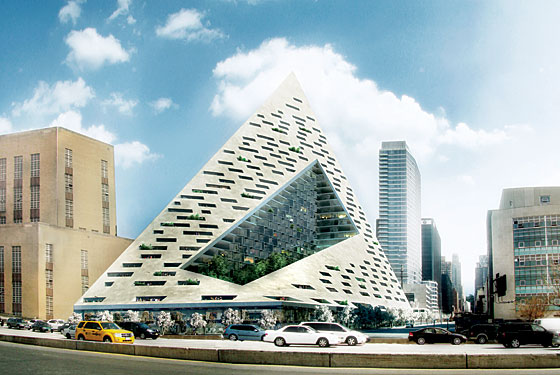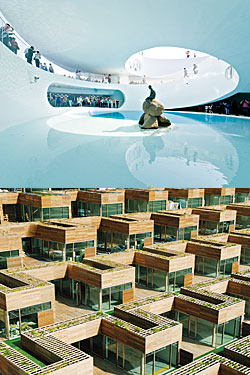
Architects mature slowly; prodigies are rare. Yet at an age when most of his peers are still sitting in cubicles, laboring over light fixtures and door handles, Bjarke Ingels, a photogenic 36-year-old Dane with offices on two continents and projects on three, is about to revamp one of New York’s basic units: the apartment building. In every growth spurt, rental towers pop up all over the city like architectural acne, a pox of large, unsightly blocks whose creators claim it’s the best they can do, given financial realities and a restrictive zoning code. Ingels has flicked away those excuses. For the desolate juncture of 57th Street and the West Side Highway, he has designed an utterly unexpected form, neither tower nor slab nor even quite a pyramid, but a gracefully asymmetrical peak with a landscaped bower in its hollowed core. It looks wild, but it’s born of logic; true originality is the inevitable endpoint of rigorous thought.
On yet another biting cold day, Ingels cheerfully locks his foldable bicycle to a street sign in Chelsea and slides into a diner banquette to discuss his New York debut. Having naughtily dropped a few public hints about the project before his client, Durst Fetner Residential, was quite ready for the attention, he is now simultaneously excited and cagey. The new building, he explains, will fuse two apparently incompatible types: a European-style, low-rise apartment block encircling a courtyard, and a Manhattan tower-on-a-podium, yielding something that looks like neither and behaves like both. New York is ready to embrace such a griffin, he insists: “This is the country that invented surf and turf! To put a lobster on a steak—any French chef would tell you that’s a crime.”
Ingels, who has been a visiting professor at Rice University, Harvard, and Columbia, is an unabashed Americanophile. “Europeans like to declare the U.S. dead, but it’s a convenient fiction,” he says. “So many European architects have been influenced by America, and I’m interested to discover that part of Danish culture.” So he has become a part-time New Yorker; he’s rented an apartment in Tribeca, opened an office in Chelsea, and bought a vintage Porsche for jaunts out of town.
Copenhagen gave his career a running start. Ingels had just come off three years at the Office for Metropolitan Architecture, Rem Koolhaas’s Dutch genius factory, and he and a former associate got the job of building the Copenhagen Harbour Bath, a peaked wooden iceberg from which kids can dive into newly limpid city waters. By 2005, his first residential project had sprouted in the planned quarter of Ørestad, an open field fifteen minutes by subway from downtown that now houses a concert hall designed by Jean Nouvel. Ingels was attracting plenty of interest, but he was still feeling cut off. “The natural transit of the international intelligentsia through Copenhagen is quite limited,” he says drily.
Well before opening a New York outpost, the Bjarke Ingels Group, founded in 2005 and known by its swaggering acronym, BIG, had turned American-style surf and turf into an architectural philosophy. One of the Ørestad projects merged suburban development with dense city living by stacking little houses with yards into a precipitous mound over a parking garage. To emphasize the building’s loftiness, a steel façade displays a perforated image of Everest. For a native of a little platelike country, Ingels sure has alpine cravings: BIG has just won a competition to build a waste-to-energy plant that will loom over Copenhagen’s lagoon—and double as an artificial ski slope.
Now he is bringing the mountain to Manhattan. Durst’s West 57th Street site is a large, unpromising oblong plot pointing toward the liftoff point of the West Side Highway and flanked by an active but largely empty steam plant and a new garbage-truck garage. Ingels’s design capitalizes on the city’s steady march to the ever-more-verdant riverfront, where industry meets leisure. He and his architects had multiple tasks: turn the building toward the water, leave neighbors’ views as intact as possible, and negotiate a transition from the low-slung silhouette of Hell’s Kitchen to the long-necked towers of Riverside South. At the same time, Ingels wanted to make a “blatant” connection with Hudson River Park, and pull its greenery into the heart of the architecture in the form of a spacious court. To open up views, the building dips down at its southwestern corner. To mitigate traffic noise, it pulls back from the highway and the sanitation garage, rising along a steep, continuous slope to a sharp 450-foot summit. These methodical steps yield a sierralike outline familiar from as far back as Copenhagen’s Harbour Bath, and while that shape may one day devolve into a stylistic tic, for now it feels natural and fresh.

In a gridded city, reason would seem to dictate an architecture of seamless planes and perpendicular lines, but Ingels has found a more efficient eccentricity. Balconies slash the inclined plane. The apartments slant away from the corridor like fishbones so that windows on 58th Street frame westward views. Ingels is a virtuoso of repetitive protrusions: Instead of facing the building with a slick screen of glass, he breaks it into a Cubist expanse of windowed bays.
The design still has a long parade of approvals to win, beginning with a community- board presentation on February 9, but already it’s clear that without giving up a rentable square foot, busting a frugal developer’s budget, or requesting more than minor tweaks to city rules, Ingels has reinvented a type of architecture that seemed immune to innovation. To understand just how difficult that is to pull off, it helps to look a few blocks away, at Eleventh Avenue and 54th Street, where Ten Arquitectos is making a similar attempt to bundle greenery, rental apartments, and commercial space into an unorthodox topography. There, in a building to be called Clinton Park and now under construction, an S-shaped slab with a terraced roof climbs from a low-rise to a block-long tower. The separate parts join awkwardly, with none of the Durst project’s choreographic grace.
In videos of his interviews and talks, Ingels comes across as a supercharged amalgam of talent, charm, and overpowering ego. In person, he adopts a slightly sheepish version of his public persona, as if not quite sure how his brashness will play. Gauging reactions is not just an aspect of his temperament, but a strategy of radical adorableness. An inspiration is sometimes indistinguishable from a sales pitch. To prove that an apparently lunatic quartet of Himalaya-shaped towers could be constructed with simple materials and traditional techniques, he had his staff erect a room-size model out of 250,000 Lego bricks.
When it was time to issue the firm’s first monograph, instead of producing another sober coffee-table-crusher, he decided to make it a graphic novel, starring himself. With his superhero’s jaw and camera-ready uniform (black hoodie over black T-shirt emblazoned with a speech-bubble logo), he makes a plausible Architectureman. Still, it was a characteristically cheeky move: The darling of academe risked looking unserious, and potential clients might shudder at the thought of one day turning up as comic-book villains. But Ingels wanted to present built works as endpoints of stories that included wrong turns and setbacks as well as bolts of insight. (One frame shows a client reacting to a proposal in alarm: “He thought it looked like something designed by Darth Vader.”) And lest readers be misled into thinking Ingels was being self-deprecating, the book begins with a declaration of lineage. A suite of full-page photographs of prophets and their evolving mottos—Mies van der Rohe (“Less Is More”), Robert Venturi (“Less Is a Bore”), Philip Johnson (“I’m a Whore”), Ingels’s former employer Rem Koolhaas (“More Is More”), and Barack Obama (“Yes, We Can!”)—culminates in a picture of Ingels himself. The book’s ringingly cryptic title is an amalgam of all these slogans: Yes Is More.
The swashbuckling architect makes an odd pair with Douglas Durst, the shy, shambling scion of the New York real-estate family who is introducing Ingels to America. Durst was a prime mover in the reinvention of Times Square—he put up the Condé Nast Building and the crystal tower at One Bryant Park—but he has generally opted for experienced, deliberate firms like FXFowle and its spinoff, Cook + Fox. A revolutionary he is not. When the Copenhagen City Council invited Durst (whose wife, Susanne, is Danish) to give a talk about green high-rises in 2006, an affably obnoxious young architect waylaid him afterward to ask: “Why do all your buildings look like buildings?” By rights, Durst should have snickered and walked away. Instead, he kept in touch, caught a show of Ingels’s work at the Storefront for Art and Architecture.
Then, two years ago, Durst needed a new idea. He had controlled the 57th Street lot for nearly a decade, and in that time it had generated a procession of abortive ideas: a data-processing center that seemed too vulnerable after 9/11, a private school that was never able to get financing, a residential skyscraper that proved impractical, and a more modest low-rise that would wrap around a courtyard. On another trip to Copenhagen, Durst toured BIG’s offices and was impressed that such a young firm should have so many and such varied projects under construction, ranging from the Danish pavilion for the Expo 2010 Shanghai to a fantastical national library in Astana, the capital of Kazakhstan.

“Bjarke doesn’t have a style that he imposes on all his projects,” Durst says. “He makes an effort to understand what the client needs.” Durst especially liked a plan for a three-sided Stockholm airport hotel where each façade, seen from a distance, resolved into a portrait of one of the children of the Swedish king. I ask Durst if he plans to engrave his own children’s likenesses on the side of his new building, and he laughs. He did, however, name a rental tower after his daughter Helena.
What drew Ingels to Durst was not just a valuable connection, but the developer’s reputation for merging profit and environmental activism. “Sustainability is not just for tree-hugging romantics who have an ideological image that the world was better before,” Ingels says. “It’s economical and even profitable: A small extra effort in construction can produce a bonus that lasts for years. But if you’re working with developers who are thinking in the short term, then it doesn’t make a lot of sense. That’s what I like about Durst: They’re going to keep the building forever.” In New York’s unsentimental real-estate climate, he has found fresh support for his belief that making the client happy is the ultimate creative challenge.
“Colleagues warned me that working with American developers would be impossible because all they think about is money. But developers that don’t think about money don’t exist for very long. Durst wants to make the neighborhood as desirable and livable as possible, and this project is about trying to make a place where there isn’t one now.” (One-fifth of the apartments will be set aside as affordable housing.)
A few weeks later, Ingels calls from Davos, where he’s holding court at the World Economic Forum. “I’m neither a politician nor incredibly rich, but there are a lot of real-estate people here, and quite a bit of our work has to do with social and environmental issues,” he shouts over a squawky cell phone. Then he has to go. Dinner is being served, and the guests are clamoring. It’s time for Architectureman to tend to his burgeoning fame.
